We thought we had found the number one adventure in South America, the 5 day “W” Circuit hike in Chile, but we’re thinking the Salt Flats, beginning in Tupiza, Bolivia and ending in Uyuni is by far the best. Sitting in a 4WD for 8-10 hours a day and sleeping on slabs of concrete and salt at an altitude above 3600m did not take away from the awe inspiring beauty of the Bolivian Altiplano.
Death bus ride
First we had to survive the eight hour bus journey from Tarija to Tupiza on what is commonly known as the “Death Bus” with approximately twenty vehicles a year ending up on the canyon floor. Many travellers had warned us to avoid this bus route at all costs due to landslides increasing the journey time considerably, passengers actually having to assist in the clearing of the dirt road, drunk bus drivers, and the obvious risk of hovering over the precipice below. The first 2-3 hours were easy asphalt driving until we made the turn towards Tupiza where things changed dramatically. The road appeared to be carved out like a shelf on the side of the mountain. The three bus companies that drive this route will only travel at night because the darkness gives easy vision of vehicles coming from the opposite direction. Unfortunately for Andrea she had the side of the bus that seemed to cling to the edge of the road for the next three hours, whilst I had the rock face to look at from the bus window. Sleep doesn’t come easy in these conditions and we both stared out of the window all night. Fortunately, we, like most passengers had a safe and sober driver and made the journey without any issues and were comfortably at Hotel Mitru in Tupiza by 3.30am.
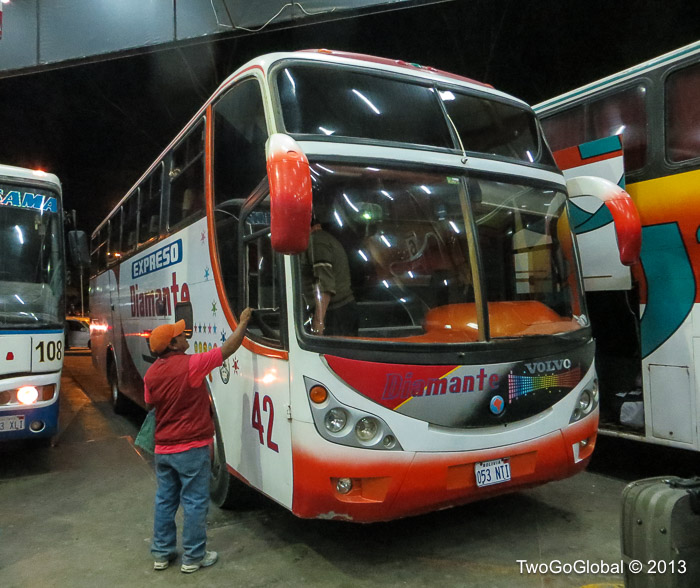
This certainly makes our bus look better than it really was!
Tupiza
We started our bus journey in Tarija at 1854m and we were now in Tupiza at 2850m providing the necessary acclimation for when we head above 5000m in the next few days. The air definitely felt thinner here and made our afternoon hike to La Cruze overlooking the city a little demanding. Still, it felt good and hopefully our bodies had created a few more red blood cells! There wasn’t much else for us to see in the city and we were raring to meet our Tupiza Tours Salt Flats companions at 8am the following morning. There were two Landcruisers heading out on our tour, both with a driver/guide and one would carry our chef – once again, we had heard horror stories about drunken drivers and poor services from online reports and hoped we would luck out. So far so good and we shared our Toyota Landcruiser with a mother and daughter from Ireland and in the other vehicle were Belgian and Dutch couples. We didn’t know it yet, but we couldn’t have hand-picked a better group to hang with for 4 days.

Local kid practicing for the circus
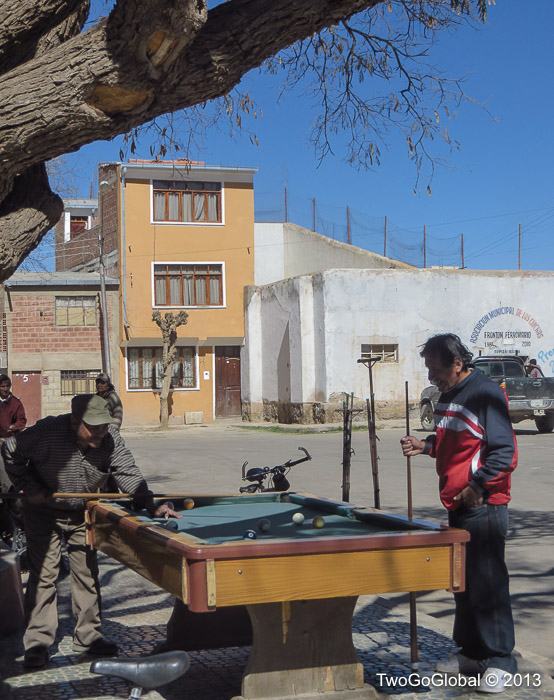
Open air pool

Tupiza’s plaza and cathedral

La Cruze, sitting 200 meters above Tupiza
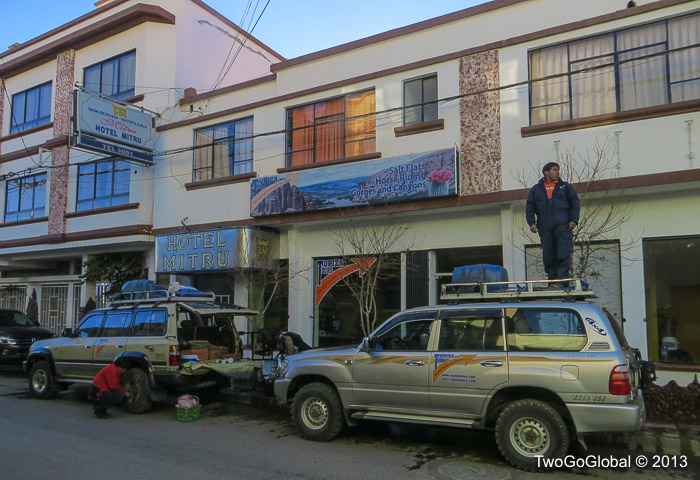
The two Toyota 4WD’s and our driver loading up
Day 1
As soon as we met Aishling and Margot (our Landcruiser mates) we agreed to swap rows every other day so no one was stuck on the tiny 3rd row the entire time – it worked out very well. Marco, our driver, made sure the windows were always clean so we could see out and take photos from inside without any problems.
Upon leaving town we were instantly on a dusty dirt road which the 4WD handled well, skillfully assisted by our driver who when asked if he was entering the Dakar rally that is passing through the Salt Flats in 2014, replied “Yes!”. There were times when we were flying over the dirt roads but we never felt unsafe.
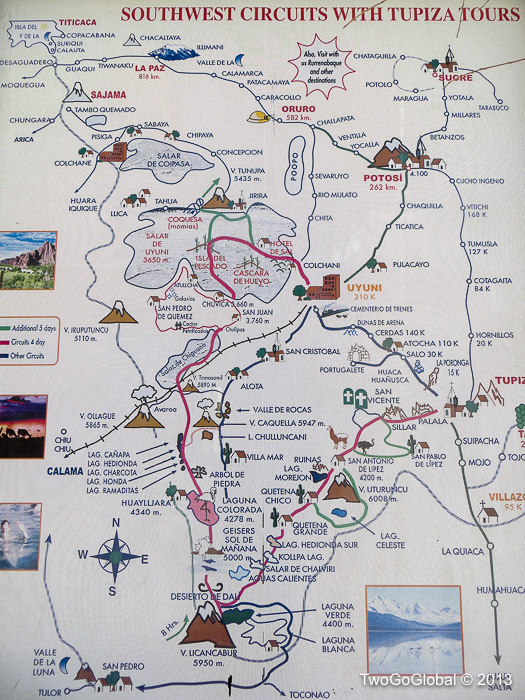
Our 4 day route across the altiplano in red

Fantastic scenery
The first few hours were all uphill passing spectacular scenery as we wound along the narrowest of roads with switchback after switchback. I remember one of the days climbing Aconcagua some years ago passing through an ice field with jagged spikes of ice rising into the air, looking amazing, well we were now going past rocks with the same formations in an area known as Quebrada de Palala, and then El Sillar, or the saddle. Llamas were in abundance grazing on the very tough grasses, many with pretty red bows in their ears, probably identifying which farmer they belonged to. We passed by silver mines still used today although on a much smaller scale to previous times – I can’t imagine the small amounts they must extract as there are no major displays of wealth out here!

Amazing rock formations

One of the few silver mines we saw still in existence
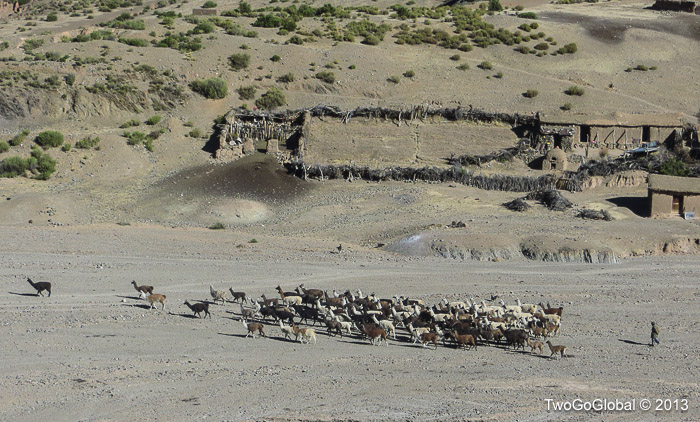
A herd of domesticated llamas being rounded up by the farmer
After re-inflating flat tire number one we stopped for lunch in a small town called San Vicente, a very rustic village where all the buildings are made from clay bricks and thatch roofs. Lunch was outstanding and Sylvia paved the way for all of our meals going forward. It was surprising what she could whip together on limited resources. The lunch stop clay brick house, actually closer to a hut even had a vintage TV on the wall showing soccer!
While we were chowing down, Marco, our driver and the other Tupiza Tours driver repaired the punctured tire – we assumed just swapping for a spare but these guys are multitalented and they removed the wheel, drove over the tire with the other vehicle to release it from the rim, then patched the inner tube before reassembling everything. This must be a pretty common type of repair, but they asked us not to take pictures of their process – hmmmmm.

Flat tire no. 1

San Vicente where we ate lunch at one of the houses on the left

Cost me 3 Bs for this photo – young entrepreneurs!

Washing and what looked like beef jerky on the same line

San Vicente’s church
In the afternoon we passed by the ruins of San Antonio, a Ghost Town at an altitude of 4200m – this was once a booming gold town of more than 5000 people but has been uninhabited since the mid 1980’s. We heard that miners here spent 30 days inside the mine at a time, what a life! The only signs of life we saw were long tailed rabbit like rodents known locally as Vizcachas.
Andrea gained a new altitude record a little farther on when we reached 4855m, still a fair bit lower than what we were going to reach in the coming days. It’s difficult to even imagine that we’re driving on the Altiplano at altitudes not too much lower than the highest mountains in Europe and Africa!
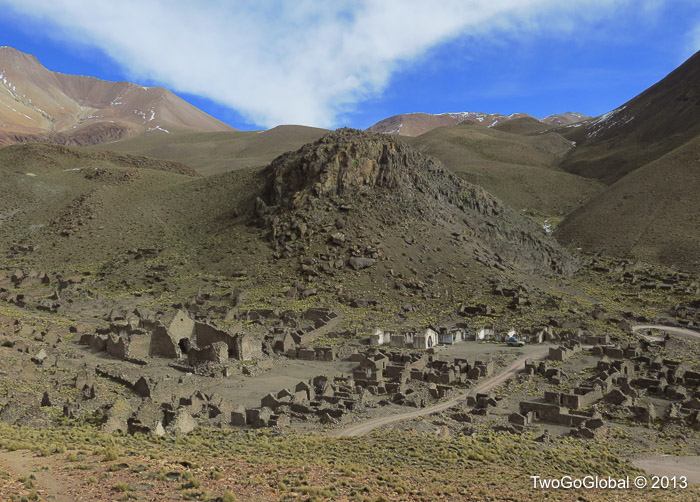
The ruins of San Antonio, an old gold mining town

Andrea’s highest point in 39 years, soon to be beaten
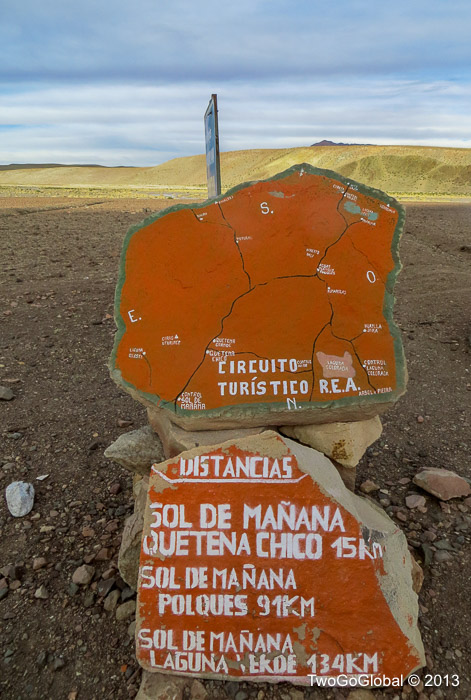
Entry to the Eduardo Avaroa national reserve
After entering the Eduardo Avaroa national reserve, bordering Chile, we arrived at our first night’s accommodation, a small town named Quetena Grande, where we were blessed with having electricity and running water! Dinner was another miracle and it always included a starter and dessert thanks to our great cook. We ate whilst the drivers were outside in the cold fixing puncture number two – now we know why they repair flats. There wasn’t much for us to do after eating as heating is non-existent and power for lights is at a premium so we hibernated early.
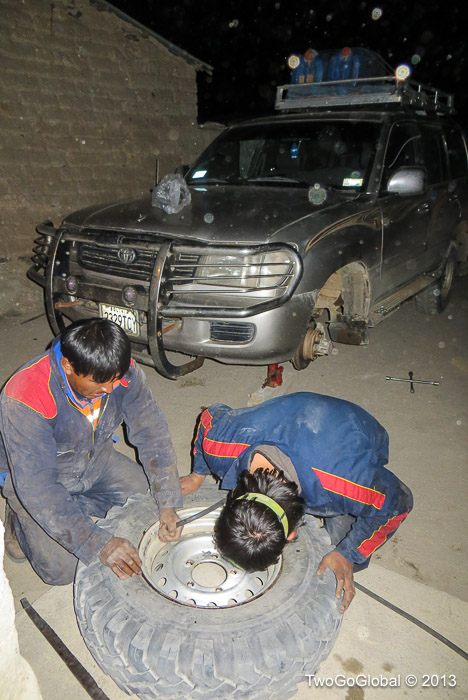
Our drivers hard at work

The concrete foundation beds we slept on – fortunately with lots of bedding
We all expected to be freezing in the night, but with six blankets on the bed we were all quite toasty. We both added our sleeping bags to the insulation, especially as we couldn’t push the concrete foundation beds together. No one from our group slept very well in these conditions – the thickness of the bedding and the altitude kept every one up most of the night.
Day 2
Morning arrived with cold temperatures and very bright blue skies. The sun at these altitudes is extremely intense but we still needed a down jacket outside the vehicle. Today we were going to see many lagoons, including hot springs, geysers and flamingos.

Our driver preparing the vehicle for the long day ahead

Crossing icy streams was not uncommon at this altitude
Our first stop was Laguna Hedionda Sur, totally ice covered and made for some silly photos, followed by a couple more frozen lakes that were being harvested for different types of minerals, including a natural washing detergent. We were now reaching areas that the weather gods had closed off some days earlier, but with our driver’s excellent navigation and skill we crossed the very barren Salvador Dalí Desert and reached Lagunas Verde and Blanca. Laguna Verde was perhaps the most impressive location we had witnessed so far with multicolored hillsides, a snow covered Volcan Licancabur sitting at 5950m, and obviously a green lagoon.

You would have thought we were pro’s

Harvesting minerals from the lagoons
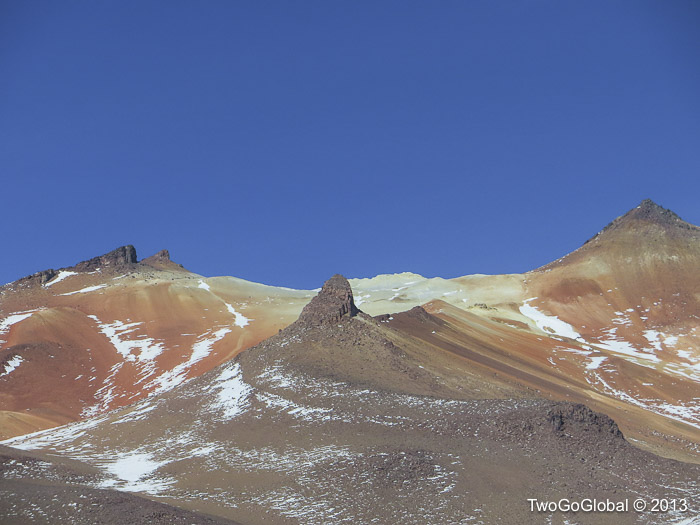
Multicolored hillsides
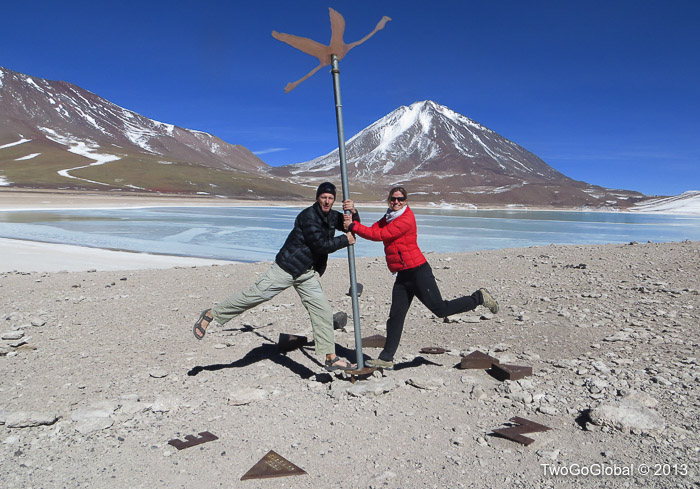
Laguna Verde with 5950m Volcan Licancabur in the background
We were all really looking forward to the next stop, Aguas Calientes, where we were going to bathe in the hot springs prior to lunch. After 20 minutes in the thermal pool, no one wanted to get out! To top it off the backdrop for these lagoons was forever impressive with 6000m snow capped peaks surrounding us.

Argggggh, aguas calientes
We had chosen the best time of year and location to be doing this tour as the vast amount of groups start from Uyuni instead of Tupiza making our lunch, accommodation and other stops far less touristy. In the busy season there are around 75 vehicles leaving Uyuni and 25 from Tupiza, whereas we left Tupiza with only five or six other groups on the same schedule. The Uyuni traffic was now making a presence as there was a line of SUV’s sitting outside the building where we all had lunch – we could not imagine visiting these areas in the busy season with the amount of extra traffic and people!
The afternoon continued where the morning left off with spectacular vistas and something we did not get to explore so close up in Rotarua, New Zealand, boiling mud pools and geysers. We couldn’t get within twenty meters of anything hot in New Zealand, but here in Bolivia you could give yourself a mud facial treatment if you were dumb enough and could handle the sulfur smelling air! This moon-like area is called “Geisers Sol de Mañana” which we were fortunate to have on our itinerary because a few days earlier there was a huge dumping of snow and at 5000m clearing the dirt roads doesn’t happen easily! Incidentally I think we reached 5200m which made the summits of the surrounding mountains and volcanoes seem easily attainable.
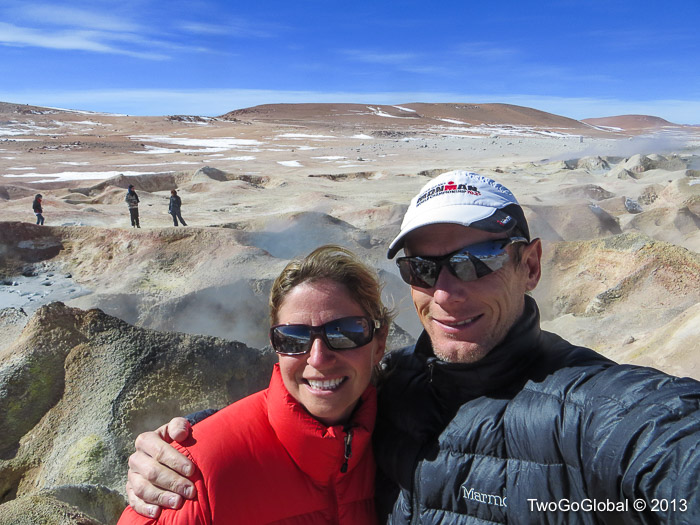
The spectacular geysers at Sol de Mañana

Boiling mud

A rip roaring geyser blowing off steam
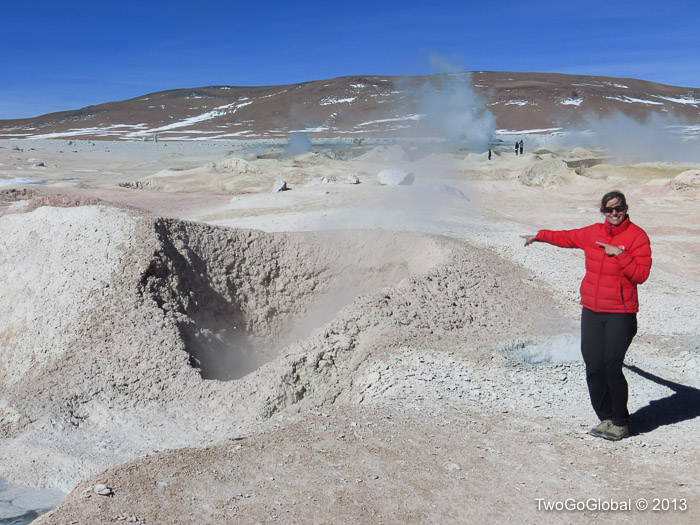
Andrea kindly pointing out a pool of continuously spluttering boiling mud
Now for my favorite part of the day, lagoons full of photogenic flamingos. We had already glimpsed a few the day before but nothing like what was to come! Close to our second night’s luxury accommodation, Laguna Colorado is a red colored lagoon full of the algae that flamingos feed on giving them their pink/red coloring. We headed there after dumping our backpacks off at Huaylljara, a small community close to the shores of the lagoon only in existence for passing tourists. There were groups of flamingos everywhere, happily filtering algae from the water until the arrival of many other two legged creatures made them waddle off around the lagoon!

A very red Laguna Colorado

Flamingos coming in to land
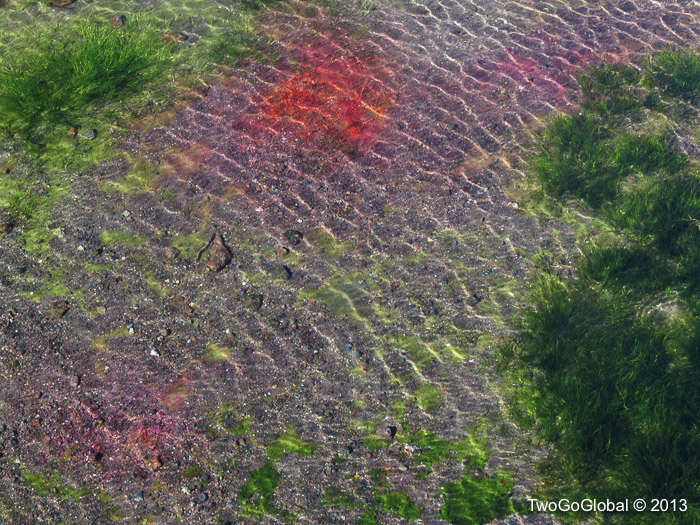
The algae that gives flamingos their distinct coloration

James’s Flamingos
This was to be the perfect end to our second day of being cooped up in an SUV for many hours – the stops, some of them brief, and some like the hot pools for longer made it all worthwhile and we never had a dull moment. There were definitely a few hairy moments with tankers and trucks forcing us to move into plowed snow and speeding through dust clouds but we survived another day on the Bolivian Altiplano.
July 5th – July 8th 2013

